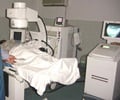Artificial intelligence using certain biomarkers in the eyes can indicate how healthy your kidneys are.
- As the eyes and kidneys have a similar developmental pathway, diseases affecting these two organs can be diagnosed together
- Artificial intelligence-powered biomarkers on the retinal image can denote the presence of kidney disease //
- Regular screening of the eyes can help detect renal diseases
Furthermore, retinal micro-vascular characteristics have been found to predict chronic kidney disease. Diabetes, hypertension, smoking, and obesity are all vascular risk factors for chronic kidney disease, as are pathogenic pathways such as inflammation, oxidative stress, endothelial dysfunction, and micro-vascular dysfunction.
Although age-related biomarkers have been linked to kidney failure, practical application has been difficult. The retinal age gap (retina-predicted age minus chronological age), a validated clinical and artificial intelligence-driven aging biomarker based on retinal imaging, was linked with the future risk of kidney failure among UK residents in a recent study published in the American Journal of Kidney Diseases (AJKD). This non-invasive and age-related biomarker could help identify people at high risk of kidney failure.
Previous research has extensively documented the link between retinopathy and CKD. However, few previous investigations only have looked at the potential link between retinal vascular characteristics and CKD.
In the Multi-Ethnic Study of Atherosclerosis (MESA), smaller retinal arterioles were found to be linked with the incidence of CKD in white exudates. Both retinal arteriolar and venular constriction were related to blood creatinine in the Atherosclerosis Risk in Communities Study (ARIC).
Screening to Preserve Vision and Kidney
Microvascular retinopathy is generally regarded as non-threatening to vision, although diabetic retinopathy and macular degeneration are not. Patients with diabetes should have their retinas screened every two years, or more frequently if abnormalities are found. Patients with macular degeneration grades 4 and 5 should be evaluated by an ophthalmologist. Interventions can help diabetics keep their vision, and monitoring can help prevent the consequences of macular degeneration and other retinal illnesses.And with this study, it is a clear sign to get your kidneys examined in case of any eye disease, as it would serve as a precautionary measure to safeguard your kidney by catching any kidney related abnormality at an early stage.
Source-Medindia
















